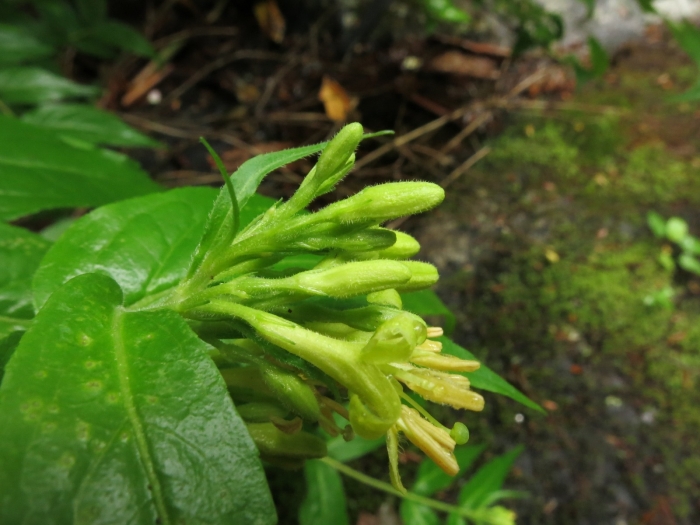Mountain Bush Honeysuckle
(Diervilla rivularis)
Mountain Bush Honeysuckle (Diervilla rivularis)
/
/

Evan M. Raskin
CC BY 4.0
Image By:
Evan M. Raskin
Recorded By:
Copyright:
CC BY 4.0
Copyright Notice:
Photo by: Evan M. Raskin | License Type: CC BY 4.0 | License URL: http://creativecommons.org/licenses/by/4.0/ | Rights Holder: Evan M. Raskin | Publisher: iNaturalist | Date Created: 2016-06-26T12:08:36-07:00 |






























Estimated Native Range
Summary
Diervilla rivularis, commonly known as Mountain Bush Honeysuckle, is a deciduous shrub native to the Appalachian Mountains, thriving in woodland edges, open forests, and along streambanks in the Southeastern United States. It typically grows to a height of 3-6 feet (0.9-1.8 meters) and a width of 4-8 feet (1.2-2.4 meters). The plant features ovate to lanceolate leaves and clusters of small, trumpet-shaped yellow flowers that bloom in early to mid-summer, which are particularly attractive to pollinators. The flowers are not particularly showy but add a subtle charm to the plant’s overall appearance.
Mountain Bush Honeysuckle is valued for its adaptability to a range of soil conditions and its ability to stabilize soil, making it an excellent choice for erosion control. It is also used for naturalizing in wild gardens and for mass plantings in landscape borders. This shrub is low maintenance, tolerating both full sun and partial shade, and prefers medium water with well-drained soil. While it is not known for any significant disease or pest issues, it can occasionally suffer from leaf spots or powdery mildew. One of its key horticultural attributes is its resistance to deer browsing, making it a good choice for areas with high deer populations.CC BY-SA 4.0
Mountain Bush Honeysuckle is valued for its adaptability to a range of soil conditions and its ability to stabilize soil, making it an excellent choice for erosion control. It is also used for naturalizing in wild gardens and for mass plantings in landscape borders. This shrub is low maintenance, tolerating both full sun and partial shade, and prefers medium water with well-drained soil. While it is not known for any significant disease or pest issues, it can occasionally suffer from leaf spots or powdery mildew. One of its key horticultural attributes is its resistance to deer browsing, making it a good choice for areas with high deer populations.CC BY-SA 4.0
Plant Description
- Plant Type: Shrub
- Height: 3-6 feet
- Width: 4-8 feet
- Growth Rate: Moderate
- Flower Color: N/A
- Flowering Season: Summer
- Leaf Retention: Deciduous
Growth Requirements
- Sun: Full Sun, Part Shade
- Water: Medium
- Drainage: Medium
Common Uses
Bee Garden, Bird Garden, Border Plant, Butterfly Garden, Drought Tolerant, Erosion Control, Fragrant, Groundcover, Hummingbird Garden, Low Maintenance, Street Planting
Natural Habitat
Native to woodland edges, open forests, and streambanks in the Appalachian Mountains
Other Names
Common Names: Hairy Bush-Honeysuckle , Bach-Buschgeißblatt , Gulrött Getris
Scientific Names: Diervilla rivularis , Diervilla sessilifolia var. rivularis
GBIF Accepted Name: Diervilla rivularis Gatt.